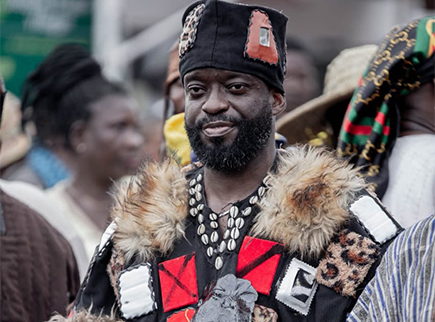The Teyuyru procession, a key highlight of the annual Asogli Te Za, has once again lived up to its billing as one of Ghana’s most captivating cultural spectacles, attracting thousands of people from across the country and beyond.
The procession, which dates back generations, began as a symbolic ritual to hoot at hunger and to welcome the new yam harvest. Over time, it has transformed into a grand cultural display that continues to unite and inspire the Asogli State.
This year’s turnout was exceptional, as the forecourts and streets of Ho were filled with jubilant crowds, dancing troupes, chiefs, and visitors, all eager to witness the vibrant celebration.
Drumming and chanting resonated across the city, accompanied by energetic dances that created an atmosphere of joy and renewal.
Traditional horns and gong-gongs added rhythm, ensuring the celebration retained its authentic identity.

Togbe Agblatsu III, a sub chief of Bankoe, described the event as “a festival of life,” saying it was not just about the yam harvest, but also about resilience, unity, and continuity of heritage.
“The Teyuyru shows who we are as a people — strong, proud, and together,” Togbe Adu-Bobi, the Afetorfia of Ho Bankoe told the Ghana News Agency.
The cultural aesthetic was particularly striking. Chiefs and elders appeared in resplendent Adewu and warrior cloths, adorned with ornamented talisman.
Women, youth, and children joined in with patterned fabrics that seems to be odd, headscarves, and symbolic body adornments, odd dressing was the style of the day, the body arts and their outfits blending into a dazzling mosaic of tradition and style.
Floats and masquerades further heightened the spectacle. Some carried symbolic objects of the yam harvest, while others performed dances rooted in centuries-old ritual, thrilling the crowd with every display.
The artistic use of colour was unmistakable. Dark – Red, and blue dominated the procession, each representing different facets of Asogli’s identity — courage, wealth, vitality, and unity.

For visitors, the Teyuyru procession was not only a visual feast but also a deep cultural immersion. Tourists mingled freely with locals, often joining in the dances and chants that filled the streets.
“This is more than a festival. It is a living history lesson,” another attendee noted, adding that such experiences help bridge generations.
The Asogli State Council described the event as “a reaffirmation of cultural pride,” stressing its importance in transmitting values of hard work, generosity, and togetherness.
Indeed, the 2025 Teyuyru procession once again underscored its position as a cultural treasure, one that has grown in scale and significance, and continues to bring Ghanaians and visitors together in shared celebration.

